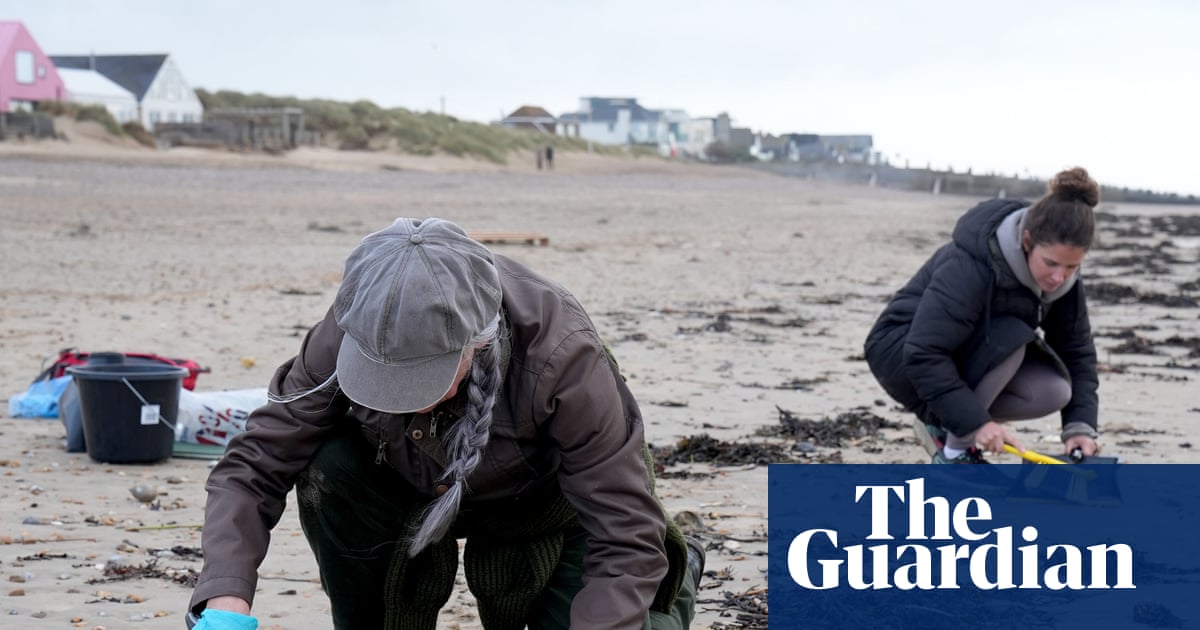The massive spill of plastic beads at Camber Sands is devastating for local people, wildlife and tourism and the beads are dispersing along the coast, residents heard at an emotional public meeting on Thursday.
Millions of tiny, toxic plastic beads are thought to have escaped into the sea from Eastbourne sewage works in East Sussex about two weeks ago when a screen keeping them in broke. They began to wash up on Camber Sands beach last Thursday, with the situation worsening over the weekend.
Environment Agency sources suspect this is one of England’s worst ever plastic pollution events, with approximately 10 tonnes of beads spilled: the plastic pollution campaign group Strandliners has estimated it is probably about 650m beads.
“This is catastrophic,” Sarah Broadbent, who chairs the 1066 Country tourist board, told the meeting attended by hundreds of local people, Southern Water representatives, and the area’s MP Helena Dollimore. “We really rely on tourists here, who come for the beach. We will be at the bottom of everybody’s holiday list now.”
She and other local people depended on the beach for their happiness and mental health, she said: “The beach is a factor in everyone’s lives here. This is catastrophic for us.”
While it will be impossible to completely remove all of the hundreds of millions of beads, the people at Camber continue to work to find as many as they can. Photograph: Gareth Fuller/PA
Richard Oakes, the local Environment Agency officer, told the meeting he expected the incident could be upgraded to a category 1 pollution event, the most serious kind.
He confirmed that the beads had been found along the coast, from Hastings to Dungeness, and also inside Rye Harbour. The harbour nature reserve, a site of special scientific interest, is loved by local people, with its big skies and the salt marshes popular with wading birds, and it had been hoped the beads would not penetrate that far.
When Oakes confirmed the beads were being found in the salt marsh there, the people in the room let out a sad sigh. There were whispers of “no”.
“What I am really worried about,” said Dollimore, “is when birds start washing up dead on the reserve. I think that will be extremely upsetting.”
Anthony Skinner, who runs a kitesurfing company at Camber Sands, is one of the 175 people who have spent days on their hands and knees using sieves, tweezers and dustpans and brushes to try to clean the beach. He and other people turned up to the meeting to get some answers from the water company and the Environment Agency.
“I was one of the first on the site,” said Skinner, “I’ve been raking the seaweed to expose the beads underneath. Our beauty spot has been tainted, it will change people’s perception of the coast. We were already dealing with sewage and runoff from the roads, now we have to cope with this pollution too.”
skip past newsletter promotion
The planet’s most important stories. Get all the week’s environment news – the good, the bad and the essential
Privacy Notice: Newsletters may contain information about charities, online ads, and content funded by outside parties. If you do not have an account, we will create a guest account for you on theguardian.com to send you this newsletter. You can complete full registration at any time. For more information about how we use your data see our Privacy Policy. We use Google reCaptcha to protect our website and the Google Privacy Policy and Terms of Service apply.
after newsletter promotion
Plastic beads on the beach at Camber Sands. Photograph: Andrew Aitchison/In Pictures/Getty Images
Hastings and Rye is the most deprived constituency in Kent and heavily relies on its tourist industry. There are also concerns the spill will hit the already struggling fishing industry, as the beads are toxic to marine life. “The fishers are having a hard time already, and now they have these toxic beads to put up with,” said the mayor of Rye, Andy Stuart.
Southern Water customers this year received the highest bill increase in the country, with rates rising by an average of 47%. This feels like a double injustice to those dealing with pollution from the company.
John Penicud, the managing director of wastewater at Southern Water, told the meeting that the Eastbourne treatment site was old, “built in the year 2000” and that a screen on the tank holding tonnes of plastic beads, which are used to filter sewage water, had broken. He added that five other Southern Water treatment centres used these beads.
He said the company was “really sorry” for the spill and committed to paying for the cleanup, but confirmed some of the money for this would come from customer bills. Penicud said it would be paid for with a “mixture of funds” – investment from shareholders and customer bills.
He said new treatment sites no longer used the beads, only sites built in the 1990s and 2000s. “In our new plant construction since the early 2000s we don’t use beads any more. We use something called membrane technology.”
While it will be impossible to completely remove all of the hundreds of millions of beads, the people at Camber continue to work to find as many as they can. “We are very upset at what’s happened. We feel very strongly about it,” said Dollimore, “I think the incident is probably one of the biggest plastic pollution incidents in this country ever, definitely one of the biggest on the south coast of England in history. And it’s really serious.”

